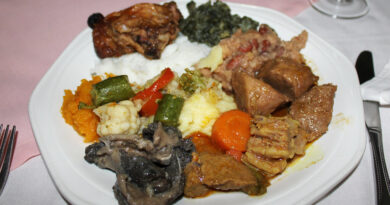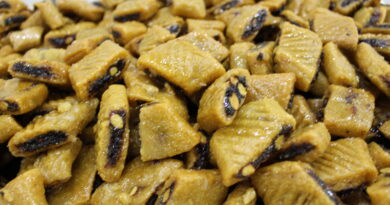Mesfouf
Mesfouf: A Staple of North African Cuisine
North African cuisine is a diverse, flavorful, and rich blend of traditions, spices, and ingredients that tell stories of history, culture, and community. One dish that stands out in this culinary tapestry is Mesfouf, a type of sweet or savory couscous traditionally enjoyed across North Africa, particularly in Tunisia, Algeria, and Morocco. This light and fluffy couscous dish is often served during special occasions, holidays, and family gatherings, embodying the essence of communal dining in these regions.
Mesfouf is more than just a food; it is a reflection of the connection between people and the land, showcasing the agricultural richness of the region, the importance of seasonal ingredients, and the deeply rooted customs surrounding food. Whether it’s served as a celebratory dish during Ramadan or simply enjoyed as a hearty breakfast or dessert, Mesfouf has an enduring presence in the kitchens and hearts of North Africans.
In this article, we’ll explore the origins, cultural significance, ingredients, and preparation of Mesfouf, as well as its place in modern cuisine. By the end, you’ll not only have a deeper understanding of this beloved dish but perhaps feel inspired to try it at home.
Origins and History of Mesfouf
To understand Mesfouf, it’s essential to first appreciate the significance of couscous in North African culture. Couscous, the base of Mesfouf, is a staple grain in many parts of the Maghreb region, which includes Algeria, Tunisia, Morocco, and Libya. Couscous is made from semolina wheat, which is rolled into tiny granules and steamed to perfection. It serves as a foundation for a wide variety of dishes, both sweet and savory.
Mesfouf is essentially a variation of couscous, distinguished by its light, fluffy texture and the unique ingredients that give it either a sweet or savory profile. Unlike traditional couscous dishes, which are often served with meat, vegetables, and sauces, Mesfouf is typically simpler and lighter, making it an ideal dish for breakfast, dessert, or a light snack.
The origins of Mesfouf can be traced back to the Berber people, the indigenous inhabitants of North Africa, who are believed to have been the first to cultivate and use couscous. The Berbers developed methods for steaming couscous that have been passed down through generations, evolving but remaining a central part of the region’s food culture. Mesfouf, with its specific preparation methods and flavor profiles, represents a localized adaptation of couscous that highlights the versatility of this ancient grain.
Cultural Significance of Mesfouf
Mesfouf holds a special place in North African culinary traditions, especially in Algeria and Tunisia. It is often prepared during significant cultural and religious events, such as Ramadan, Eid, and other celebrations. Its role during the holy month of Ramadan is particularly noteworthy. After a long day of fasting, Mesfouf is served to provide a light, nutritious, and flavorful meal that is easy to digest. The dish’s delicate sweetness and airy texture offer a gentle way to break the fast, providing energy without overwhelming the stomach.
In Tunisia, Mesfouf is also commonly served as a breakfast dish, sometimes made savory with the addition of broad beans (known as Mesfouf bel foul) or simply with a drizzle of olive oil. In Algeria, it’s often enjoyed as a dessert, flavored with raisins, nuts, and powdered sugar, showcasing the adaptability of the dish across regions and personal preferences.
Beyond its place at the dining table, Mesfouf also symbolizes community and togetherness. Like many traditional North African dishes, it is often prepared in large quantities and shared with family and friends. The act of making and serving Mesfouf is a communal one, where each family member might have a specific role in preparing the couscous, steaming it to perfection, or adding the final touches before serving.
Ingredients and Variations of Mesfouf
At its core, Mesfouf is a simple dish made from couscous, but what makes it special are the additional ingredients that turn this basic grain into something truly unique. Depending on the occasion, region, and personal preference, Mesfouf can be either sweet or savory.
Core Ingredients:
- Couscous: The base of the dish, couscous is made from semolina wheat and is steamed to create a light and fluffy texture. It serves as the blank canvas onto which various flavors and ingredients are added.
- Olive Oil or Butter: Olive oil or butter is often used to add richness and help separate the couscous grains. In sweet versions of Mesfouf, butter is more commonly used, while olive oil may be used for savory variations.
- Raisins or Dried Fruits: In sweet versions of Mesfouf, raisins or other dried fruits like apricots and dates are used to provide natural sweetness and texture.
- Nuts: Almonds, pistachios, or pine nuts are often added to sweet Mesfouf, giving it a crunchy texture and a nutty flavor that contrasts with the softness of the couscous.
- Sugar: Powdered sugar or honey is sprinkled on top of sweet Mesfouf, offering a final touch of sweetness.
- Broad Beans (Fava Beans): In savory versions, especially in Tunisia, broad beans are added to the dish to create a more substantial and hearty meal. This variation is often served for breakfast or as a light meal during Ramadan.
- Cinnamon and Spices: Cinnamon is a common addition to sweet Mesfouf, while savory versions may include spices like cumin or coriander.
Popular Variations:
- Mesfouf bel Foul (Mesfouf with Fava Beans): This is a savory version of Mesfouf, commonly eaten in Tunisia. Broad beans are steamed with the couscous, and the dish is seasoned with olive oil, salt, and sometimes a squeeze of lemon. This variation is nutritious and filling, making it a popular choice for breakfast or a light meal.
- Sweet Mesfouf: In Algeria and Morocco, sweet Mesfouf is a common dessert or celebratory dish. The couscous is steamed and then mixed with raisins, dried apricots, almonds, and sometimes pistachios. It’s then dusted with powdered sugar and cinnamon, creating a sweet and fragrant dish that pairs beautifully with mint tea.
- Mesfouf with Butter and Sugar: A simple but delicious variation, this version of Mesfouf is made by steaming couscous and mixing it with melted butter, sugar, and sometimes a dash of cinnamon. This dish is often enjoyed as a breakfast or dessert.
- Mesfouf with Dates: Dates are a beloved fruit in North Africa, and their natural sweetness pairs perfectly with couscous. In this variation, chopped dates are mixed into the steamed couscous, along with butter and a touch of cinnamon.
How to Make Mesfouf at Home
Making Mesfouf at home is a simple process, but it requires attention to detail, particularly in the preparation of the couscous. The key to a successful Mesfouf lies in properly steaming the couscous to ensure it’s light and fluffy. Here’s a basic recipe for sweet Mesfouf, which you can adapt to your taste by adding or omitting ingredients.
Ingredients (Serves 4):
- 2 cups couscous (preferably medium or fine-grain)
- 1/4 cup olive oil or butter
- 1/2 cup raisins or dried apricots (chopped)
- 1/4 cup almonds or pistachios (optional)
- 2 tablespoons powdered sugar
- 1/2 teaspoon ground cinnamon
- Pinch of salt
- Water for steaming
Instructions:
- Prepare the Couscous: Place the couscous in a large bowl and drizzle with olive oil or melted butter. Toss the couscous to coat the grains, then sprinkle with a pinch of salt. Add about 1/2 cup of water and use your fingers to gently fluff the couscous, ensuring that the grains remain separate.
- Steam the Couscous: Set up a steamer or a couscoussière (a special pot designed for steaming couscous). Place the couscous in the steamer and steam it for about 10-15 minutes. Remove the couscous, fluff it with a fork, and add a little more water if necessary. Return the couscous to the steamer for another 10 minutes, until it’s light and fluffy.
- Prepare the Raisins and Nuts: While the couscous is steaming, soak the raisins or dried apricots in warm water for about 10 minutes, then drain. Toast the almonds or pistachios in a dry pan until they’re golden and fragrant.
- Assemble the Mesfouf: Once the couscous is done steaming, transfer it to a serving bowl. Stir in the raisins, nuts, and a sprinkle of cinnamon. Drizzle with a little more melted butter or olive oil, if desired.
- Finish with Sugar: Sprinkle powdered sugar over the top of the Mesfouf, and serve warm.
- Serve: Mesfouf is traditionally served with mint tea, which balances the sweetness of the dish. Enjoy it as a dessert, breakfast, or light snack.
Savory Variation – Mesfouf bel Foul (with Fava Beans):
If you prefer a savory version, omit the sugar, raisins, and nuts. Instead, steam 1 cup of broad beans (fava beans) along with the couscous. Season with olive oil, salt, and pepper, and serve with a wedge of lemon for a refreshing twist.
Nutritional Benefits of Mesfouf
Mesfouf is not only delicious but also nutritious. Couscous, made from semolina wheat, is a great source of carbohydrates, providing energy and fiber. Whole wheat couscous, in particular, contains higher levels of fiber and nutrients. The inclusion of dried fruits like raisins and apricots adds natural sweetness and provides important vitamins such as potassium, iron, and antioxidants.
Nuts like almonds and pistachios offer healthy fats, protein, and additional nutrients like vitamin E and magnesium. These ingredients combine to create a dish that is both satisfying and nutritious, making it a well-rounded meal for breakfast or dessert.
In savory versions, the addition of fava beans or broad beans adds a significant amount of plant-based protein and fiber, making Mesfouf bel Foul an excellent choice for those looking for a filling, meatless meal. Beans are also rich in vitamins and minerals such as folate, iron, and potassium.
Mesfouf in Modern Cuisine
As global culinary trends continue to shift towards more plant-based, whole-food diets, dishes like Mesfouf are gaining international attention. The versatility of couscous, combined with the health benefits of ingredients like nuts, dried fruits, and legumes, makes Mesfouf an appealing option for those looking for nutritious, satisfying meals that are easy to prepare.
In recent years, Mesfouf has also been featured in restaurants and food blogs outside of North Africa, as more people discover the rich flavors and traditions of the Maghreb. Whether served as a sweet dessert, a light breakfast, or a savory snack, Mesfouf fits perfectly into the modern desire for simple, healthy, and flavorful dishes.
Conclusion
Mesfouf is a dish that embodies the heart and soul of North African cuisine. Its simplicity, versatility, and deep cultural significance make it a cherished part of family gatherings, religious celebrations, and everyday meals across Tunisia, Algeria, and Morocco. Whether you prefer it sweet or savory, Mesfouf offers a taste of the Maghreb that is both comforting and nourishing.
By learning to prepare Mesfouf at home, you can bring a piece of North African tradition to your kitchen, enjoying the timeless flavors and wholesome ingredients that have made this dish a staple for generations. As the world continues to embrace global flavors, Mesfouf stands out as a testament to the beauty of traditional, communal, and sustainable cooking practices that celebrate both food and culture.



